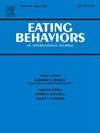妊娠期食物渴望接受与行动问卷的验证
IF 2.4
3区 医学
Q2 PSYCHIATRY
引用次数: 0
摘要
对食物的渴望在孕期很常见,并可能引发饮食失调行为,包括暴饮暴食和饮食失控,从而对母体和胎儿的健康造成危害。用有理论依据和经验验证的方法来评估食物渴望的内在机制,对于推进针对渴望的研究和临床干预至关重要,因为渴望是妊娠期饮食紊乱及其不良后遗症的预测因素。孕妇(n = 305)完成了由十个项目组成的食物渴望接受和行动问卷(FAAQ),该问卷是对食物渴望的接受程度(因子1)和体验食物渴望的意愿(因子2)的测量,同时还完成了食物渴望问卷-特质-减少(FCQ-T-r)、产前饮食行为筛查工具(PEBS)和爱丁堡产后抑郁量表。确认性因素分析结果显示,FAAQ 原始的十项双因素结构拟合度较差,但与之前建立的七项双因素 FAAQ-II 的拟合度极佳(CFI = 0.96,RMSEA = 0.07,TLI = 0.94,删除了项目 1、3 和 6)。总分(α = 0.68)和分量表得分(α = 0.76、0.79)的内部一致性信度良好。FAAQ-II得分与FCQ-T-r得分显著相关(r = -0.37 to -0.56,p <.001),支持建构效度。FAAQ-II 评分可区分临床上是否存在明显的进食障碍(PEBS ≥34,p < .001),并且与孕前体重和情绪症状有明显关联。FAAQ-II 在该样本中表现出很强的心理测量特性,支持将其用于评估孕期对食物渴望的接受程度和意愿。本文章由计算机程序翻译,如有差异,请以英文原文为准。
Validation of the food craving acceptance and action questionnaire (FAAQ) in pregnancy
Food cravings are common during pregnancy and can trigger disordered eating behaviors, including binge and loss of control eating, which pose risks to maternal and fetal health. Assessing mechanisms underlying food cravings with theoretically informed and empirically validated measures is crucial for advancing research and clinical interventions that target cravings as predictors of disordered eating and its adverse sequelae during gestation. Pregnant individuals (n = 305) completed the ten-item Food Craving Acceptance and Action Questionnaire (FAAQ), a measure of acceptance of (factor 1) and willingness to experience cravings (factor 2), along with the Food Craving Questionnaire – Trait – reduced (FCQ-T-r), the Prenatal Eating Behaviors Screening Tool (PEBS), and Edinburgh Postnatal Depression Scale. Confirmatory factor analyses yielded poor fit for the original ten-item, two-factor structure of the FAAQ but excellent fit for the previously established seven-item, two-factor FAAQ-II (CFI = 0.96, RMSEA = 0.07, TLI = 0.94, with items 1, 3, and 6 removed). Internal consistency reliability was adequate for total (α = 0.68) and subscale scores (α = 0.76, 0.79). FAAQ-II scores correlated significantly with FCQ-T-r scores (r = −0.37 to −0.56, p < .001), supporting construct validity. FAAQ-II scores differentiated participants with versus without clinically significant disordered eating (PEBS ≥34, p < .001) and were significantly associated with pre-pregnancy body mass and mood symptoms. The FAAQ-II demonstrated robust psychometric properties in this sample, supporting its use in assessing acceptance of and willingness to experience food cravings during pregnancy.
求助全文
通过发布文献求助,成功后即可免费获取论文全文。
去求助
来源期刊

Eating behaviors
Multiple-
CiteScore
4.20
自引率
3.60%
发文量
65
审稿时长
60 days
期刊介绍:
Eating Behaviors is an international peer-reviewed scientific journal publishing human research on the etiology, prevention, and treatment of obesity, binge eating, and eating disorders in adults and children. Studies related to the promotion of healthy eating patterns to treat or prevent medical conditions (e.g., hypertension, diabetes mellitus, cancer) are also acceptable. Two types of manuscripts are encouraged: (1) Descriptive studies establishing functional relationships between eating behaviors and social, cognitive, environmental, attitudinal, emotional or biochemical factors; (2) Clinical outcome research evaluating the efficacy of prevention or treatment protocols.
 求助内容:
求助内容: 应助结果提醒方式:
应助结果提醒方式:


